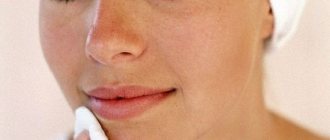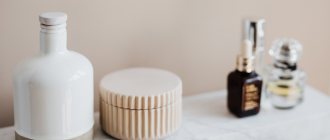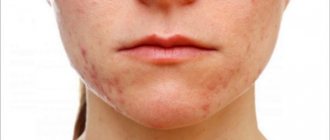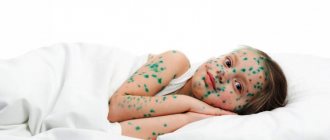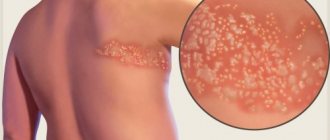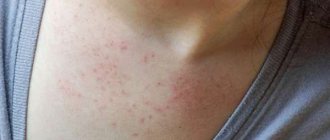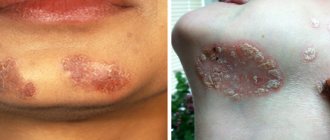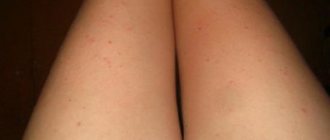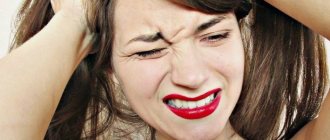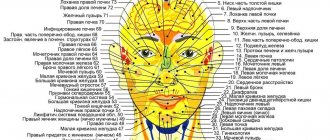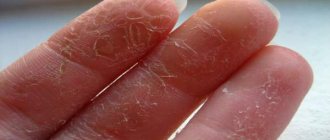A rash on the chin of a child is not uncommon. Sometimes the cause of irritation is a simple lack of personal hygiene or poor nutrition. In some situations, acne indicates the development of dangerous diseases.
Healthy baby skin of pink even color without rashes
All types of rashes on the face in children with explanations and photos: causes of pimples and methods of treatment
It has long been known that beauty and health are interconnected.
Skin is an indicator of the body's well-being. If it is smooth and velvety, then the person is healthy. Various rashes and changes in the color of the skin indicate malfunction of any of the body systems. In this case, treatment is not always required - sometimes lifestyle changes are enough. What to do if you find a rash? A rash on the face of a child has various causes, so before starting treatment it is necessary to determine the etiology of the disease
Why might a child develop a rash on his face?
There are a lot of diseases that are accompanied by a rash. In order to distinguish them, you need to take into account the nature of the rash: color, size, dynamics of manifestation. The accompanying symptoms cannot be ignored. All rashes can be classified into 2 groups:
- primary - affecting healthy skin;
- secondary - appear as the primary develops.
The table shows the most common primary rashes:
Types of rashes on the face in children of different ages
As already noted, the rash can be primary or secondary. Primary rashes are of greatest interest because they are the most common. It is with their diagnosis that difficulties arise. Based on shape and appearance, the following varieties are distinguished:
- Tubercles are non-hollow lumps on the skin.
- Blisters are dense areas that rise above the level of healthy skin. Blisters are an allergic reaction to poison from plants and insects.
- Papules, or nodules, are non-hollow elements that differ in height and color from healthy skin. They usually go away on their own.
- Bubbles are small pimples. They have a pronounced center filled with cloudy liquid.
- Bubbles are large formations (from 0.5 cm).
- Pustules are pimples filled with pus.
- Spots are changes in the color of the skin.
- Roseola are small pink or red spots that disappear when you apply pressure to the affected area.
Roseola nursery
Red rash
Acne can also appear in a child due to poor hygiene. If the baby is covered with bright pimples, then this is a skin reaction to pollution, to which children are especially susceptible in the first 6 years of life. To prevent your child from becoming covered with a painful crust on delicate areas of the skin, carefully monitor the baby’s cleanliness and accustom him to water procedures.
A consequence of unfavorable thermal effects is hyperhidrosis, or prickly heat. It manifests itself most clearly in infants, starting at one month of age. The baby’s body has not learned to adapt to the ambient temperature, so spots appear on his head and shoulders from sweat. All treatment comes down to frequent exposure of the little patient to the fresh air and regular ventilation of the premises.
Red spots on the forehead, cheeks and shoulders are often a sign of allergies. During lactation, this means that the mother should adjust her diet and also abandon aggressive household chemicals.
Allergic rashes
Red pimples in a child are also observed with toxic erythema. The rash occurs in the facial area: on the head, forehead, cheeks, nose. Newborns and babies under one year of age are most susceptible to it. This type of rash does not require specific treatment and disappears on its own within 7-8 days. At a later age, erythema is rare and, as a rule, is a consequence of uncomfortable living conditions: humidity, ambient temperature.
As mentioned above, red rashes can be infectious in nature and observed in the following diseases:
- measles;
- rubella;
- scarlet fever;
- chickenpox.
Chicken pox rash
The most dangerous possible cause of skin changes is meningitis. The disease is severe and in some cases is fatal. A characteristic feature of the infection is a rapid increase in body temperature and the gradual spread of an itchy rash throughout the body. If you have the slightest suspicion of meningococcal infection, you should immediately consult a doctor.
White pimples
Milia, or white pimples, are a type of acne that occurs in adolescents during hormonal changes. They are a small cyst formed as a result of excess sebum. Appear on the cheeks, nose, forehead. The causes of milia are varied: poor diet, poor-quality cosmetics, hormonal imbalance. As a rule, rashes disappear on their own with age (at 15-16 years of age). If not, you should visit a dermatologist or endocrinologist.
The predominant localization of milia is the area around the eyes, cheekbones, and T-zone (forehead-nose-chin). It is impossible to squeeze out such a tubercle - the source is deep under the skin. To get rid of white pimples on the face, you need to adjust your diet and provide quality skin care by choosing products that correct the functioning of the sebaceous glands.
Similar rashes also occur in newborns and go away on their own within 1-2 months of life.
Milia in a newborn
Colorless rashes
Small colorless rashes that resemble nodules are called neonatal acne. Neonatal cephalic pustulosis appears on the face of children during the first month of life. This is how the baby’s skin reacts to the remnants of maternal hormones. No specific treatment is required - the baby will soon adapt to new living conditions. Acne usually goes away on its own within a few days, weeks or 1 year.
Colorless or flesh-colored watery pimples on the cheeks in later life may indicate a malfunction in the immune system: this is how a food allergy or reaction to emotional stress manifests itself. This phenomenon is called dyshidrosis. In emotionally stable children, it goes away on its own; otherwise, therapy is required, including the use of weak sedatives.
Minor rash
If the fever is accompanied by low-grade body temperature (from 37.0 to 37.5 °C), allergic hyperemia, a systemic disorder or a sluggish infection occurs. In the presence of dermatological diseases (pyoderma, erythema, urticaria), body temperature may not increase.
Treatment
Treatment of acne in children should be carried out only after a thorough examination aimed at establishing the exact cause of the rash.
To make an accurate diagnosis, you need to visit a pediatrician and dermatologist, as well as get advice from an endocrinologist, allergist, and immunologist.
- Allergic acne can be cured by adjusting the diet of the child and mother (if the baby is breastfed). If the allergen is another irritant (pet hair, cosmetics, etc.), then it is important to determine what exactly the baby is sensitive to and, if possible, eliminate contact with the allergen. In some cases, antihistamines may be required.
- A rash of an infectious nature can be treated only with the medications prescribed by the pediatrician. Infections are often accompanied by a serious deterioration in the baby’s general well-being, and in this case, timely medical attention is very important.
- Properly selected cosmetics will help you get rid of prickly heat. It is best to use powder or baby cream containing zinc.
- Neonatal acne usually resolves in babies by 6 months of age and does not require specific treatment. To cleanse, you can wipe the skin with a decoction of string or chamomile.
In addition, it is important to follow general recommendations to help quickly cure acne in a child.
- Small children should be washed with boiled water at least 2-4 times a day.
- It is better to bathe infants in decoctions and infusions of chamomile or string. You can also use a very weak solution of potassium permanganate (potassium permanganate).
- When bathing an infant, it is better not to use soap products more than 2-3 times a week, and when bathing a child older than one year - more than 5-6 times.
- During water procedures, cosmetics should be washed off thoroughly.
- Residues of food and other contaminants from the face of a small child should be removed with wet wipes that do not contain alcohol.
Creams, gels and other acne treatments intended for adults cannot be used to treat children. Also, you should absolutely not squeeze out your baby’s pimples.
Watery pimples on the face
Unfavorable ecology, stressful situations that follow a person’s heels, a huge variety of allergens that occur in our lives, have provoked various kinds of rashes on the face and body. Painful and not so painful, small and large, white and red, purulent pimples and acne. What a person has to deal with.
Some react calmly to a rash, for others, pimples on the face cause anxiety, while others panic and look for a way out of the current situation. But everyone wants to know the cause of skin rashes and how to eliminate them. Let's focus on pimples filled with water.
How to treat
It will take time to treat purulent acne on the chin. There is no way to quickly get rid of this disease.
A course of therapy is carried out to treat inflammatory processes that have led to purulent formations.
The following types of treatment are distinguished:
- using medications;
- using surgery;
- using traditional medicine methods.
Medication
The sick person should be examined by a dermatologist, gastroenterologist and endocrinologist. As a result of the research, he is prescribed the required course of treatment.
The list of drugs used for treatment will depend entirely on the identified cause of purulent formations.
External means
The most commonly prescribed medications are in the form of ointments:
- zenerite;
- erythromycin;
- basiron.
Domestic
Prescribing these drugs is recommended as a last resort. Most of them are antibiotics.
Among them:
- retinoids help open pores and keep them open;
- corticosteroids. Agents that act on the focus of inflammatory processes. This is an extreme measure in the fight against purulent formations.
Folk remedies
Traditional methods can be used as additional measures to treat purulent manifestations.
The following tools have worked well:
- mustard. It is used in the form of a mixture that must be applied to the pimple for thirty minutes;
- garlic. Garlic is rubbed, this consistency is applied to the purulent formation with preliminary lubrication with vegetable oil. Next you need to cover this place for twenty minutes;
- oat flour. The white of a chicken egg is taken, placed in oatmeal flour and mixed. Apply the resulting consistency to the chin or entire face as a mask. Let sit until dry, approximately twenty-five minutes. Then everything is washed off with water;
- nettle leaves. A decoction is made from them, which is drunk for a month. Helps remove toxins from the body and restore metabolism;
- burdock roots. A decoction is made from crushed burdock roots, you will need one tablespoon. The resulting solution is filtered and allowed to brew. Reception is carried out four times a day, one hundred milliliters at a time;
- aloe. Aloe leaves are first cleaned of needles, then cut and the juicy pulp is applied to the purulent formation. Fix it with a bandage and leave it while you sleep. There have been cases of acne disappearing in one application.
The nature of watery acne
The appearance of any acne is directly proportional to the condition of your body. There are no health problems, the metabolism is in perfect order, the nervous system is strong - the skin is clean and smooth. Any disruption in the body causes unpleasant rashes to appear on the skin. Are you experiencing watery pimples on your face? Let's look at the reasons for their appearance. Let us only note that such pimples can settle on the face of both a newborn and an elderly person. Few people managed to protect themselves from such a misfortune.
A cold or skin disease leads to the appearance of water pimples: Thus, painful small blistering pimples on the lips, chin, and wings of the nose indicate the Herpes virus. Blisters in the form of papules indicate waterpox. In the active phase, shingles causes watery pimples on the face and entire body. Five types of lichen are known. The disease is infectious in nature and requires medical intervention.
With scabies, the appearance of watery pimples is accompanied by severe itching, which intensifies at night. First, the rash rashes on the hands, and then the rash spreads throughout the body. Excessive sweating also leads to the appearance of such acne. A water pimple can be a sign of prolonged exposure to the sun. The cause of the rash may be a weakened immune system.
Today, scientists have proven that the causative agent of water acne is considered to be molluscum contagiosum. The harm is aggravated by the fact that the mollusk is able to move, causing a rash in different parts of the body. An infectious microorganism lives in the pimple itself (upon closer examination, a black dot is visible). The mollusk gets onto the body from a reservoir without much difficulty if a person has minor injuries on the body (scratches, abrasions). Self-medication is excluded. The only sure way is to visit a dermatologist and undergo an examination (skin scrapings, other tests), which will not only remove the symptoms, but also get rid of the problem forever.
Dermatosis
It is worth noting that the presence of red spots on a child’s chin may indicate dermatosis, a skin disease in which the skin is actively affected, becoming covered with dry, flaky spots.
Dermatosis is a skin problem that can occur as a result of fungi, viruses, allergies, and also due to vitamin deficiency. Also, the cause of this problem may be an insect bite.
If the spots are rough, the cause is most likely a violation of certain metabolic processes in the child’s body. As for sensations, the problem in question may be accompanied by itching, as well as the presence of blisters in some places.
In order to establish the true cause of dermatosis, parents should show their child to a doctor, who will recommend a series of tests and, based on their results, prescribe an effective remedy.
Traditional medicine in the service of man
Since ancient times, any skin diseases have been treated with folk remedies. Grandmother’s recipes will also help cure watery acne on the face. It is recommended to wash your face with tar soap at night. The latter tends to strongly tighten the skin. Therefore, after washing, you need to wipe your face with alcohol-free lotion and moisturize with cream. On the Internet you can find a recipe for making tar soap at home. It will be an excellent mask. Apply thick soap foam to your face and leave for several minutes. Afterwards, rinse with warm water and moisturize your face with cream. A decoction or tincture of calendula or chamomile remains an indispensable skin care product.
You can prepare the following tincture: Take equal parts of calendula flowers, chamomile and clover leaves, add the juice of a third of a lemon, pour in 10 ml of alcohol and keep for a week in a dark place. Treat your face with this solution twice a day. Or you can prepare a standard decoction of these medicinal flowers (2-3 spoons per glass of warm water; leave for 20 minutes) and wipe your face. Herpes on the lips can be lubricated with earwax. The substance has antibacterial and anti-inflammatory properties. The result is guaranteed!
Prevention
As for the prevention of rashes that occur as a result of infectious diseases or dermatological problems, it is unlikely that it will be possible to prevent their occurrence.
Sooner or later, the child will become infected and will get sick. And in this case, it is important to make a timely diagnosis and carry out competent treatment.
As for other types of rashes, their occurrence can be prevented by following general tips for caring for delicate and sensitive baby skin.
Recommended:
- observe the temperature regime in the baby’s room (optimal air temperature 18–22 °C);
- change diapers more often and give the baby air baths;
- dress the baby in underwear and clothes made from natural materials;
- to wash children's clothes, use special hypoallergenic products (the age at which they can be used is usually indicated on the packaging), and do not wash the dishes with detergent solutions, but boil them;
- monitor the child’s nutrition, and if the baby is breastfed, the mother should follow the diet;
- carefully select baby formula (preferably together with a pediatrician);
- before walking in hot (summer) or frosty (winter) weather, apply special protective agents to the baby’s skin;
- use repellents to protect your baby from insect bites;
- keep toys clean.
What will the specialist say?
A leading specialist in the field of dermatology with twenty-five years of experience, Sergeev T.D. sees the problem this way: “Water acne on the face, as a rule, occurs with herpes. They are usually located in groups, often merging into a large blister. The disease causes itching and burning of the skin and may be accompanied by general malaise and chills. Not everyone knows that the Herpes virus can be transmitted by airborne droplets and remain in the human body forever. Any factor (reduced immunity, hypothermia) leads to illness.
Small pimples appear on the patient’s face (usually on the lips and nostrils), preceded by itching.” The doctor advises to fight such rashes with antiviral drugs and special creams. It is not recommended to pierce blisters or peel off dry scabs: you can get new rashes. Sergeev T.D. warns against alcohol abuse during treatment. Otherwise, recovery will be delayed. Watery pimples, like any other, should be carefully protected from sunlight by covering them with clothing.
Photos before and after
See how to get rid of internal acne on the chin. What causes acne to appear on the cheeks of a baby? Find out further.
What does Komarovsky say about newborn acne? The answer is here.
Purulent acne on the chin is a very unpleasant and painful disease, but, of course, it can be treated.
The main task for the correct course of treatment is to identify the primary source of inflammatory processes. Knowing the cause, the attending physician is able to prescribe effective therapy that will restore the normal appearance of the chin.
Red pimples in a child - treatment methods
02/13/2017 children 3,241 Views
In the first years of life, a child’s immunity is not yet formed and is poorly protected from infections. Therefore, red pimples on the body are among the most common manifestations of diseases and care disorders. Most mothers believe that this is caused by allergies. Although in fact there are many reasons and all acne is different from each other, which makes diagnosis easier and allows the pediatrician to prescribe treatment in a timely manner.
It is difficult for parents to figure out why acne appears on their child’s body. The triggering factors for the rash are:
- Teething (the child develops pimples on the face around the mouth due to the secretion of large amounts of saliva).
- Failure to comply with hygiene standards.
- Reaction after vaccination.
- Children's clothing and bedding made of synthetic fabric.
- Skin diseases (streptoderma, dyshidrosis).
- Acne in newborns (when the mother is treated with hormonal drugs during pregnancy).
- Infectious diseases (measles, chicken pox, scarlet fever, rubella).
- Skin reaction to overheating when wrapped in warm clothes (heat rash).
- Allergy. A child's skin is sensitive to all allergens - pet saliva, washing powders, room cleaning products. Therefore, in order not to provoke such a reaction from an early age, it is necessary to choose hypoallergenic products and not have pets.
- When single pimples appear on a child’s legs, face or arms, bites from blood-sucking insects cannot be ruled out.
If pimples appear on the skin when eating certain types of food, then it is best to exclude them from the menu. When you cannot determine the cause on your own, you need to seek help as soon as possible.
Advice from Dr. Komarovsky
The famous pediatrician Dr. Komarovsky believes that the appearance of pimples in a child of a certain age is natural, and often does not require treatment.
- For example, acne that appears in a teenager at the age of 12–14 is caused by an increase in hormonal activity.
- However, the same acne at the age of 9 years can occur for other reasons - due to non-compliance with hygiene rules, early puberty, endocrine or metabolic disorders.
How to quickly remove a pimple on your nose? Find out here.
How to treat acne on the forehead? Read on.
- wash your face twice a day;
- do not squeeze pimples;
- use special cosmetics for problem skin;
- Do not touch your face with your hands unless necessary.
The appearance of acne on a child's skin can be caused by various factors.
And in order to rid the baby’s skin of rashes and prevent the problem from worsening and complications, it is important to show the child to the doctor in a timely manner.
Proper treatment can only be carried out if the cause of the inflammation of the skin is known.
An accurate diagnosis made by a doctor will be the key to a quick recovery.
Types of pimples
The rash, depending on the duration of existence on the baby’s skin and the disease, has a variety of shades, sizes, and localization. Therefore, it is important to know its external signs in order to establish the exact cause of its occurrence.
Pimples are divided into the following types:
- small with a pale red color;
- watery pimples on the body are bright red in a child or with a black dot in the center;
- pink of various sizes on the buttocks and in natural folds;
- reddish spots that quickly turn into watery pimples;
- rash with purulent contents.
- whiteheads on the face.
If a pinpoint rash appears on a child’s chin or around the mouth, this is a clear sign of excessive salivation, which irritates the skin. Watery pimples are a symptom of chickenpox. At first they are single, and then cover the entire skin and are accompanied by severe itching.
Important! If a rash appears, you should not apply oil products to these areas. They clog the sebaceous glands and the rashes will become more abundant.
They disappear unevenly and therefore some of them have liquid inside, while others burst and become crusty. Watery pimples, the photo of which is presented below, appeared with chickenpox.
In some cases, children's skin is affected by similar rashes, but they have a black dot in the center. This rash is characteristic of molluscum contagiosum. When pink pimples appear on the butt, they talk about the appearance of heat rash due to excessive wrapping in warm weather and after using diapers.
If small reddish spots first appear on the baby’s skin, and after a few days they are filled with liquid contents, this is considered a sign of streptoderma. Vesiculopustulosis will be indicated by purulent pimples, a photo of which is presented below.
They can appear on any part of the body. If left untreated, these formations increase in size, merge and form eczema.
Small white pimples on a child’s face and body appear when there is an excess of female hormones in his body. The body in this situation recovers on its own without treatment.
To get rid of acne, medications are needed to combat the underlying disease. Most often, medications are prescribed internally, but they must be combined with external methods of application. There are medicinal and home options for treating acne in children on the face and body. The use of any remedy must be agreed with the pediatrician so as not to cause an increase in reaction to it.
ChildbirthInfo
Having discovered small pimples on a baby, many parents get scared. They believe that rashes are a sign of an infectious disease or a malfunction of internal organs. However, a rash on the body of a newborn does not always indicate the development of pathology. Immediately after cutting the umbilical cord, dramatic changes occur in the child's body. They are aimed at adapting to new conditions and independent existence. The main processes of transition from intrauterine to extrauterine life take several weeks. The skin, like a mirror, reflects everything that happens in the body.
During the first three days after birth, most newborns develop milia on their skin. These are small white dots. They are located mainly on the nose, bridge of the nose, cheeks and chin. In some infants, rashes are found on the back, chest, and limbs. Milia densely cover the skin, making it look like the surface of foam rubber. In places where rash elements accumulate, the skin remains even and smooth.
Pimples on the face are associated with the formation of the skin, as well as with the adjustment of the sweat and sebaceous glands. They begin to function immediately after the birth of the child. However, by this time the outlet openings of their excretory ducts may not yet be formed. The secretion formed in the glands does not have the opportunity to come to the surface and accumulates in the skin in the form of white dots.
The appearance of milia is facilitated by a sharp change in the environment. Before birth, the baby was in amniotic fluid, the temperature of which was 37 degrees. Postpartum stress caused by exposure to dry, colder air can delay skin formation.
White pimples do not show signs of inflammation. They do not cause concern to the baby and do not contribute to the addition of bacterial microflora. White spots disappear on their own without treatment when the formation of the skin ends.
During adaptation to a new environment and the transition to independent life, a newborn child develops a hormonal crisis. Immediately after birth, the level of estrogen in his blood decreases against the background of changes in the secretion of other hormones. A decrease in the concentration of female sex hormones is observed throughout the first week of a child’s life. The changes in hormonal levels are so strong that the level of estrogen becomes tens and hundreds of times less.
The baby's skin quickly reacts to a sharp change in hormonal balance. She gets covered in newborn acne. Acne occurs on the child’s body due to stimulation of the sebaceous glands by his own and maternal androgens, the proportion of which is increasing. Hyperplastic sebaceous glands, which actively produce secretions, are colonized by lipophilic and lipid-dependent yeast-like fungi Malassezia. Microorganisms provoke the appearance of rash elements.
The rash consists of nodules measuring 1 - 2 mm. They rise above the skin, giving it a rough appearance. The elements of the rash are dense and hard to the touch. Acne looks a little like millet grains scattered across the skin. If the nodules become inflamed, the skin around them turns red. In addition to acne, comedones (blackheads) may appear on the baby's face. Elements of the rash can be single or numerous, covering the entire face and scalp. In most cases, a small number of nodules are observed. Most often they are localized on the forehead, temples and cheeks. The rashes do not cause concern to the baby.
Having discovered pimples on their child, young parents do not know what to do. Newborn acne goes away on its own without treatment. Approximately 3 to 4 months after birth, the baby's hormone levels stabilize. Reduced activity of the sebaceous glands leads to a decrease in the number of lipophilic yeast fungi and cleansing of the skin.
If pimples become inflamed, use an alcohol solution of Chlorophyllipt (1%), a solution of Clotrimazole (1%), powder with dermatol, boric and salicylic acids.
The appearance of pimples on the skin may be associated with the development of prickly heat. This is a skin irritation that occurs as a result of excessive sweating. Irritation is accompanied by rashes consisting of small bubbles with transparent contents. They can be scattered throughout the body or grouped in one place.
Miliaria often occurs in hot weather. However, it can appear in winter if the baby's room is very hot and humid. The rash is often found in newborns who are excessively wrapped. Overheating of children with not yet developed thermoregulation leads to skin irritation.
Miliaria is usually localized in areas under clothing, as well as in the folds of the skin. The rash covers the back, buttocks, neck, upper chest, armpits, groin folds, knees and elbows. Sometimes red pimples are found on the cheeks. Miliaria may cause itching.
With heat rash, the skin sometimes becomes inflamed. Bubbles with cloudy contents and red, swollen nodules the size of a pinhead appear on it. As the elements of the rash increase, large, weeping foci of inflammation form. If the affected areas of the skin are infected with pyogenic bacteria, severe pustular diseases may develop.
To prevent the development of complications in an infant, it is necessary to eliminate the factors that lead to overheating of the baby. In hot weather, you should regularly check the condition of the skin in the folds and use baby powder. It is recommended to bathe children in a decoction of medicinal herbs (chamomile, string, oak bark). To reduce itching, babies are bathed in mint infusion. 3 - 5 tablespoons of raw materials are poured into a three-liter jar and cold water is added to it. After 1 - 2 hours, the liquid is heated in a water bath for 15 minutes, then cooled, filtered and poured into the bath.
Pimples on a baby's face may be allergic in nature. The reaction develops in response to the penetration of allergens into the child’s body. They can come from breast milk, formula, or through skin contact. Allergies often occur when a nursing mother consumes allergenic foods (chocolate, citrus fruits, seafood, eggs, honey, strawberries). A rash of allergic origin appears on the baby’s body if the milk formula is not suitable for him. An allergic reaction can develop in an infant due to the presence of an allergen in the washing powder in which his clothes were washed.
Allergies cause a pink or red rash. It often resembles a nettle burn. First, single elements are formed. If the allergen is not eliminated, the reaction progresses. The rashes become numerous and gradually unite into large scaly spots. Foci of allergies begin to get wet over time.
With food allergies, characteristic bright red spots appear on the baby's cheeks. If an allergic reaction develops under the influence of washing powder, red pimples appear in the places that the fabric touches. They can accurately follow the contours of clothing.
To get rid of allergy symptoms, you need to eliminate the allergen as soon as possible. A nursing mother needs to reconsider her diet and avoid foods that can cause an undesirable reaction. If newborns are bottle-fed, it is necessary to replace the milk formula. To avoid allergies to washing powder, you need to stop using it. It is better to wash infants' clothes by hand with laundry soap. If the irritant is quickly removed, the rash will disappear within a few days. If you cannot identify the allergen, you need to consult a doctor. The progression of an allergic reaction can lead to the development of severe pathologies in children.
The appearance of a rash in an infant may be associated with the development of neonatal vesiculopustulosis. Vesiculopustulosis is an inflammation of the outlets of the sweat glands. The causative agents of the disease are bacteria (mainly staphylococci).
If the source of infection is the child's mother, congenital vesiculopustulosis is diagnosed. Its signs are detected 1–2 days after birth. If the baby was infected after birth, the acquired form of the disease is recorded. Its symptoms appear in a newborn child on the 7th - 10th day of life.
Vesiculopustulosis can develop due to improper care of the baby or against the background of prickly heat. The likelihood of developing the disease increases if the child’s environment includes people who are carriers of pathogenic microorganisms.
With vesiculopustulosis, a pink rash appears, which quickly turns into small blisters with transparent contents. Elements of the rash can be numerous, prone to merging, or single. They are usually localized in folds of skin, on the buttocks and back. The rash often covers the scalp and forehead. On the 2nd - 3rd day after the first elements of the rash appear, the contents of the blisters become cloudy. When the pustules open, ulcers appear, which later become crusty.
In weakened children, vesiculopustulosis can cause an increase in body temperature to 38 degrees and above. They may refuse to eat and become restless.
If your baby shows signs of vesiculopustulosis, you should consult a doctor. He will prescribe treatment and tell you what to do. Elements of the rash are cauterized several times a day with alcohol solutions of Fukortsin, brilliant green, and methylene blue. The disease cannot be ignored. If left untreated, the infection will penetrate into the deeper layers of the skin and cause serious complications.
It is very difficult for an inexperienced person to determine the nature of the rash. Therefore, if any rash appears on the baby’s skin, you should definitely consult a pediatrician. Pimples on the face and body may indicate the development of a viral disease. Infants are sometimes diagnosed with roseola infantum, measles, chickenpox, rubella, and enterovirus infection. Infectious diseases accompanied by a rash can cause serious complications.
Any type of pimples on the skin should not be squeezed. Medicines should only be used as prescribed by a pediatrician and under his supervision.
Greetings, friends! In this article we will deal with a rather simple issue that concerns the health of your child. We will consider the reasons for the appearance of irritation on the chin of a baby. The phenomenon is quite common, many mothers do not pay attention to it, but most still worry whether this is a symptom of some serious illness.
I would also like to draw your attention to the fact that the article will focus specifically on pimples that pop up on the chin and around the mouth. We will not take the face as a whole, because the causes and methods of treatment will be completely different. Therefore, we consider the chin.
Before we talk about the causes, let's first find out what type of rash is. These are usually small red pimples; a little less often there may be red ones with a white dot, a rod in the middle. There are two reasons for the appearance of such pimples: drool and allergies.
There are also pure white pimples, which are associated specifically with hormones and are observed in infants at a very early age, in the first months after birth. Such acne goes away very quickly with age and does not require any intervention. But they can pop up not only on the chin, but also on the face as a whole. But you and I agreed to look only at the chin.
In the first year of life, a child produces quite a lot of saliva. First, this happens because the salivary glands begin to test their work, then because the baby begins to cut teeth. Another reason may be that the child, out of curiosity, puts everything into his mouth along with bacteria, and, as you know, the more microbes in the mouth, the more saliva is produced.
I described all this in more detail in the articles:
“Why is a child drooling”;
“What time do children cut their teeth?”
Quite often, red pimples on a baby’s chin coincide with the eruption of the first teeth. During this period, a lot of saliva begins to be released, and in children it is quite “caustic” and irritates delicate skin. Parents still don’t know what to do with this saliva, so we end up with small pimples.
Why on the chin? Yes, because drool flows down just down the chin and, if you don’t wipe it off in time, it can cause irritation.
In addition to teeth, the cause may also be the pacifier, which the baby has begun to actively use. The pacifier could also become a source of bacteria in the mouth and, accordingly, excessive salivation. You can read more detailed information regarding pacifiers:
“How to accustom a child to a pacifier”;
“How to wean a child off a pacifier.”
In fact, allergic reactions occur in children not only on the chin, but also on the face as a whole. If it is an allergy to some product, then it is mainly the cheeks that suffer. “Why are the child’s cheeks red?” Therefore, you should not make hasty conclusions regarding new products.
There is one nuance here: the food had an external effect on the child’s chin. After all, as you know, babies eat very sloppily, especially if you have just started introducing complementary foods. Remains of some liquid puree may flow down the chin, which causes irritation.
Also, an allergy could not necessarily arise from food. Perhaps it's the clothes. Think about whether your child has a new jacket or sweater that he could use to rub his chin. This could be either an allergy to a given item, or simply a banal irritation that arose due to friction.
First you must clearly determine the reason. If you decide that this is drool, it means:
- Buy several bibs and change them for your child often. Bibs will protect the baby's outer clothing from getting wet; if they are not used, irritation will periodically occur due to the fact that the child rubs his chin on wet clothes.
- Wipe your child's drool often and wash him 3-4 times a day. Washing has never harmed anyone. If you wash off the remaining saliva from your chin with regular, possibly boiled water, you will prevent the recurrence of irritation.
- Maintain good hygiene. Wash pacifiers, toys, and chews that your baby puts in his mouth more often. The fewer bacteria, the less saliva will be released.
If you see that there is not so much drooling, then perhaps the reason lies elsewhere. Analyze what new food you gave your child. Perhaps you have introduced a new ingredient into complementary foods. If you remember about a new product, then try to temporarily exclude it from your diet and see the reaction.
Also, after each spoon feeding (if your baby eats sloppily and splashes everything), it is advisable to wash the child so that traces of food do not remain on the face and, in particular, on the chin.
If you maintain hygiene and begin to wash your baby more often, plus you have eliminated several foods from the diet that could cause allergies, but the pimples still do not go away and the child is capricious because of them, then you can do the following.
- Buy chamomile or chamomile in bags and brew according to the instructions.
- Use cotton pads to wipe your baby's face several times a day.
- Try wiping in turns: one day with chamomile, and the second in succession. Look at the result. Both decoctions should relieve irritation quite well.
That’s basically all, we have figured out the main reasons for the appearance of a rash on the chin of an infant and found out how to help the baby in such cases.
Pimple on the chin of a baby
my daughter is a little over a month old. It all started with one pimple. Right now there are 7 of them, they are red and full. I really want to squeeze it out, but I can’t. I don't have time to read all the posts. Maybe someone can briefly tell you what you can anoint with. Pimples ONLY on the chin.
DD, girls! Pimples with white heads began to appear on the baby’s skin, mostly on the face and head. But there are rashes on the body too. They appear, and after a couple of days they seem to go away, but a little red remains...
Pimples.
Our little one has small red pimples on her shoulders, and small ones on her cheeks and the color of her skin. What could it be?
Pimples
I’m in a panic... I looked into my throat today, it was a little painful to swallow and I saw two red pimples on the back wall, about 2 mm. in diameter!!! What could it be?
What kind of pimples?
Girls, has anyone experienced pimples like this? Small, red, as if slightly liquid. They appeared literally today (yesterday it was only under the eye - I didn’t even notice). The skin on my palm peeled off afterwards. On the face for now...
pimples
For several days now I have had these pimples only on my arms up to the elbow and one of the same type on my chin. Who has encountered this? What could it be?
pimples
Tell me, maybe someone had a rash on their body. I have small pimples on one leg between my little toe, they itch so much and don’t go away at all, like an allergy. You can’t use sinoflanka, it’s hormonal. What ointment can I apply?
Pimples
Girls, we have red small chaotic pimples (Previously they went away in the morning, now they don’t ((only around the mouth and under the nose ((maybe it’s from saliva and from the pacifier??? what can I apply??
Pimple on cheek
Good afternoon My daughter has a pimple on her cheek, it hasn’t gone away for a week now, it turns pale, then brightens. What can you anoint? What does it look like?
Pimples...
hello girls)))) we are a month old, and pimples broke out on our face... small red ones... and where there are hairs too... and somewhere they even seemed to be covered with a crust.. what is this? I read somewhere that this is normal and this happens often in newborns... like would be skin...
Pimple…..
Good day. Please tell me how to dry out a pimple on my face... this infection has come out and is spoiling my mood......:( My skin is oily, but I picked up skin care products, so I haven’t had them for a long time.... And here...
The delicate thin skin of a newborn baby is an object of special admiration for parents. Therefore, it is not surprising that mothers and fathers begin to sound the alarm if pimples appear on the child’s face from the first days of life. Why this happens and what to do about this problem, we will tell you in this material.
What it is?
Pimples on a newborn's face can be isolated, or they can occupy a fairly large area. Most often we are talking about white or yellowish wen, but there are also red hollow acne. In medicine it is called neonatal cephalic pustulosis. According to various sources, the problem occurs in many babies; pimples appear in 20-35% of newborns.
Pimples usually appear on the child's nose, forehead, cheeks and chin. Quite often, the rash appears on the scalp, as well as on the ears, behind them and on the neck. Even less commonly, pimples appear on the chest. The nature of the rash itself may vary. If there are only yellow or white wen on the skin, then these are closed comedones. If blackheads appear, which is not very typical for an early age, then these are open comedones. Purulent acne is a pustule, and if the acne looks like small balls, elevations above the skin without visible filling are papules.
Most often, neonatal pustulosis begins immediately after birth , as well as in the first month of the child’s independent life. Less often - 3-4 months after birth and very rarely - by the end of the first year of life. This phenomenon cannot be considered a disease. The problem is physiological in nature and usually goes away on its own without a trace immediately after the natural causes that caused it are eliminated. For the vast majority of babies, acne goes away within a month after the first signs appear. In some children it persists for 4-6 months.
Reasons for appearance
The causes of acne in early childhood are not fully understood.
The most convincing arguments are usually two provoking factors:
- hormonal processes in the baby’s body;
- adaptation of the child’s skin to new living conditions.
Hormonal processes are caused by estrogen, the female sex hormone, which is received by the child from the mother during pregnancy and during childbirth. This hormone causes increased production of subcutaneous fat by the sebaceous glands, as a result of which the pores become “clogged” with the secretion of the glands, the hair follicle and the gland itself become inflamed. The influence of maternal hormones on the baby’s body does not last long - several months. Then the child’s hormonal levels return to normal and remain stable until adolescence. At the age of 12-13, the same processes will begin in the body, but they will only be caused by the child’s own sex hormones.
The second reason is adaptive processes. Over the nine months of pregnancy, the baby’s skin has become accustomed to contact with the aquatic environment, because in the mother’s womb the baby was surrounded by amniotic fluid. In the first weeks after birth, the baby’s skin “adjusts” to the air environment and “learns” to work in a new mode. The debugging process takes some time, and therefore increased sebum production is natural.
Subcutaneous fat is a means of protecting the body; with its help, the skin is protected from aggressive external influences. It is not surprising that the skin of a newborn tries to protect the baby from external influences. The appearance of pimples has nothing to do with hygiene issues. Therefore, it is not worth “executing” yourself for insufficient care, as a result of which the baby became covered with acne. It doesn't depend on care.
When acne is a sign of illness
Acne in newborns is not a cause for concern, which cannot be said about rashes that are caused by dermatosis and some infectious diseases. Therefore, it is important to teach parents to distinguish between ordinary pimples, the appearance of which, as we have found out, is quite natural, and skin manifestations of a painful condition.
Pimples and blisters can appear with chickenpox, herpetic infections, various dermatoses, and allergic reactions. They can be a consequence of diaper dermatitis if they are in the groin, or contact dermatitis if they coincide in location with areas of the skin in contact with clothing or seams on clothing. A careful and thoughtful examination of the child’s body will help to distinguish neonatal acne from manifestations of the disease:
- Localization. Harmless acne is located mainly on the cheeks, nose, forehead, chin, behind the ears and occasionally on the chest. An allergic reaction usually has a wider “geography”, spreading to the body - to the stomach, back, skin folds, and butt. Diaper dermatitis is limited to the diaper coverage area. A viral infection can be located in any part of the body, but it is never limited to just one part of the body. The exception is the herpes simplex virus types 1 and 2, which usually affects the lips, nose, and nasolabial triangle.
If it is difficult to distinguish acne from a painful rash on your own, do not be shy; you should call a doctor at home. The doctor will help you understand this difficult issue and give the necessary recommendations.
Usually, a visual examination of the child is sufficient for a specialist. By its characteristic appearance, a doctor can easily distinguish acne from other possible ailments. In doubtful cases, as well as in cases of severe and deep acne, the doctor may recommend a general blood test and the contents of the purulent “head” for bacterial culture. This will make it possible to establish the exact type of microbe that caused the inflammation, as well as find out what type of antibiotics it is sensitive to.
This analysis is popularly called a stool test for dysbacteriosis. If a baby is diagnosed with abnormalities in the balance of bacteria living in the intestines, he may be prescribed drugs such as Bifidumbacterin, which will help normalize the microflora.
Pediatricians quite often prescribe stool testing for infants with acne for the presence and characteristics of intestinal microflora.
Neonatal acne in a child does not require special treatment. They almost always go away on their own as the baby’s body becomes normal. But caring parents cannot calmly look at the baby’s acne-covered face; they definitely need to do something to feel that they are giving the baby everything he needs. It is useless to convince moms and dads - every pediatrician knows this. Therefore, there are certain recommendations that, although they do not affect hormonal processes, make it somewhat easier for the child’s skin to adapt to a new environment.
The quantity and quality of acne also depends on the environment , so it is important to create a microclimate for the child in which he will not sweat much, because excessive sweating creates the preconditions not only for clogging of pores with sebaceous secretions, but also for other, less harmless skin rashes. All newborns tend to sweat, because their thermoregulation has not yet been adjusted. The optimal conditions that mom and dad can create are an indoor air temperature of no more than 20 degrees Celsius, as well as a relative air humidity of 50-70%. To do this, just buy a room thermometer and a special device - an air humidifier. This purchase is more than useful, because proper humidity in the room is also an excellent way to prevent respiratory diseases.
Bed linen in a newborn's crib should be made from natural fabrics without the use of textile dyes. During sleep, the baby's head sweats more. Therefore, it is very important that the scalp and face come into contact only with natural fabrics. Place a folded diaper, previously ironed, under your head. The diaper must be changed to a fresh one at least three times a day.
Wearing the right clothes will also help reduce sweating. There is no need to wrap the baby up. At home, the baby may well be without a cap at all, but for a walk you should dress the baby strictly according to the weather. If the child is still sweating, for example, in winter in overalls, then you should bathe him in warm water without using detergents and baby soap immediately after returning from the street and change him into dry, clean underwear.
You can bathe your child with soap only once a day. Moreover, it is better to use not a bar of soap, but soapy water, which should be prepared before bathing. Any soap, even baby soap, dries out the skin.
Often, the use of detergents only provokes excess production of subcutaneous sebum, with which the sebaceous glands will try to protect the skin from drying out.
If acne is accompanied by the appearance of a crust on the face, there is no need to remove it mechanically. It is enough to apply warm vegetable or peach oil to it 20 minutes before bathing. The softened crust will come off on its own faster. White and blackheads on a baby should not be squeezed out, wiped with alcohol, adult lotions or other cosmetics.
Acne should not be smeared with baby cream or other oil-based products, because this additionally affects the blockage of skin pores and can lead to the appearance of new rash elements. You should not use anti-acne products intended for older children, or products with antibiotics, on the baby's delicate skin.
It should be taken into account that the newborn has not yet developed his own immunity, including local immunity, and therefore his skin has great difficulty coping with the attacks of bacteria that are everywhere. This is why it is so dangerous to subject the skin to mechanical cleaning and the influence of medications. The associated bacterial inflammation will not benefit the child, and the marks that remain after squeezing out pimples can last a lifetime, ruining the child’s appearance.
Cotton pads moistened with a decoction of chamomile can be applied for 10-15 minutes to the areas most severely affected by acne. However, it should be remembered that medicinal plants can also cause allergies, so before using any herbal remedy, it is advisable to consult a pediatrician.
The baby is allowed to bathe and wash with water with a decoction of chamomile or string added to it.
It is allowed to treat the rash with a weak solution of Chlorophyllipt. It is better to use a drug that is sold in the form of an alcohol solution. Oil solution and spray are not suitable for infants. You should not carry out such procedures too often to avoid drying out the skin. Children prone to allergies should not smear their faces with this drug, since its herbal components can aggravate allergic manifestations.
The amount of acne is also influenced by the hormone cortisone, which is produced in humans under stress. If a mother who is breastfeeding a child is very nervous, then the baby receives cortisone with milk, which he generally does not need. Mom definitely needs to calm down and create favorable psychological conditions for herself and her baby.
After bathing, the child’s skin does not need to be rubbed with a towel. It is quite easy to blot it, since intense mechanical impact can lead to microtrauma with subsequent infection by pathogenic bacteria.
Any redness on the baby’s skin causes parents to worry; pediatrician Anna Ramonova will tell you about what kind of rashes their babies might have.
Drug therapy
Medicines will help reduce the severity of the rash. At the same time, it is necessary to use drugs that reduce itching, burning and swelling. The following treatment is prescribed:
- If red bumps on the buttocks and body appear due to diaper rash, then Bepanten powder and cream will help cope with the burning and swelling.
- Wiping areas of skin covered with a rash with weak solutions of antiseptics (potassium permanganate or furacillin).
- Bathing the child in these solutions or with the addition of pharmaceutical preparations (chamomile, calendula or oak bark).
- Antihistamines (Fenistil, Loratadine).
- When watery pimples appear on a child’s skin, use brilliant green and, if necessary, antipyretic drugs (Ibuprofen).
- Hormonal medications for severe itching and no effect of treatment (hydrocortisone cream). An ion-colloidal solution of silver has a milder effect.
The duration of treatment and frequency of application during the day is determined by the doctor depending on the severity of the manifestations.
Why is it important to find the reason
Clean, smooth facial skin is the calling card of any representative of the fair sex. Her condition is used to evaluate her level of grooming, lifestyle, and success.
The appearance of acne on the chin makes women sound the alarm. In this part of the face, the tubercles look especially bright and not aesthetically pleasing. Many people resort to drying cosmetics and external cleansing procedures. However, the problem often remains the same or even gets worse.
Our readers successfully use Papilite to treat papillomas. Seeing how popular this product is, we decided to bring it to your attention. Read more here...
Dermatologists never tire of repeating that acne on the face does not appear out of nowhere. Such formation is often only an external symptom of a deviation in the functioning of any internal organ. You won’t be able to get rid of acne on your chin without carefully studying the causes. In addition, during the examination, concomitant diseases can be identified and treated in a timely manner.
Watery pimples on the fingers can occur under the influence of a variety of factors. Their timely detection is the key to the effectiveness of therapy.
Infectious diseases
The appearance of watery acne can be a consequence of a variety of pathologies:
- Children's infections. When measles, rubella, scarlet fever, and chickenpox appear, blisters filled with liquid form on the skin. In this case, rashes can affect not only the hands, but also other parts of the body. Such diseases are characterized by fever, general weakness and other symptoms.
- Fungal infections. Red spots and small pimples are usually located in the area of damaged dermis - cracks, cuts and scratches.
- Pemphigus. The origin of this disease has not yet been established, but many doctors believe that the provoking factor is a viral infection. Initially, the rash affects the mucous membranes of the mouth and lips. As the process progresses, it affects the hands and other parts of the body.
In this case, the bubbles are filled with cloudy liquid. When these formations rupture, large erosions are formed.
Scabies can be identified by the following symptoms:
- Rash in the form of blisters - they are usually located on the hands and between the fingers. In more rare cases, acne is localized on the feet and forearms.
- Severe itching sensation - its intensity increases at night. This is due to the fact that the tick is actively feeding and laying eggs. Also, discomfort increases after a warm bath.
- Scabies on the skin are thin cavities of pink or gray color.
- Peeling of the dermis.
- Scratching, bloody crusts, weeping wounds, ulcers - all these signs are associated with scratching and the penetration of infection into the affected areas.
This reaction is observed in the area of skin contact with the irritating factor. It could be washing powder. At the initial stage, pimples have a white or reddish tint. Over time, the condition of the dermis worsens.
At first, a person develops small pimples. Subsequently, they become larger and become covered with crusts. Often watery rashes appear that itch.
When this problem occurs, it is important to determine the triggering factor. The formation of acne is not always associated with exposure to washing powder on your hands. The cause could be any cleaning product. Therefore, it is recommended to use rubber gloves when cleaning.
The following factors can also lead to the appearance of small watery pimples:
- use of a medicinal product;
- use of low-quality cosmetics.
Endocrine diseases
Quite often, the cause of the disorder is various pathologies of the endocrine system. Obesity may be a provoking factor. Often the cause of the disease is hormonal imbalance.
In such cases, you should immediately consult a doctor, as there is a risk of serious damage to internal organs.
Failure to comply with hygiene rules
This problem is more relevant for children. It is associated with non-compliance with personal hygiene rules. If a child does not wash his hands in a timely manner, bacterial microorganisms actively multiply on them. This often causes rashes to appear.
Other diseases
The following pathologies can also lead to the problem:
- Dyshidrosis – it is also called miliaria or dyshidrotic eczema. In this case, the rash is associated with impaired functioning of the sweat glands.
- Increased dryness - in this situation, the epithelium loses its protective functions. As a result, external factors provoke irritation and acne formation.
- Pathologies of the digestive and reproductive systems.
- Metabolic disorders - in this situation, acne first forms on the fingers. However, as the abnormal process progresses, they affect the hands and forearms.
- Damage to the nervous system - the appearance of watery rashes on the hands is often caused by stressful situations, emotional overload or nervous fatigue.
- Burns – they can occur due to improper use of various household chemicals.
Heredity
Sometimes the problem is caused by the body’s tendency to increase sebum synthesis. Rashes are also caused by hereditary dermatological pathologies - these include psoriasis, Darier's disease, and hyperkeratosis.
Diagnostic methods and therapy for chin allergies
After examining the child, the doctor will ask the parents about his contacts with animals, his diet, and whether there are any allergies in the family.
This information will allow us to suggest what exactly is a potential allergen. In addition, the specialist will prescribe diagnostic laboratory tests. They are aimed at accurately identifying the irritant that caused a violent allergic reaction.
The child will have a blood test to determine how much immunoglobulin E, which is a marker of allergies, is contained in it.
The more of this substance in the blood, the more intense the allergic manifestations. For children after seven years of age, skin allergy tests may be prescribed to help diagnose the irritant.
Parents do not need to wonder how to treat children with chin allergies. Having carried out diagnostic measures, the doctor will be able to confidently begin complex treatment, which is usually characterized by high effectiveness.
The purpose of the prescribed therapeutic course is not only to eliminate the signs of allergy, but also the source that caused the disease.
The main thing in therapy is the complete exclusion of the child’s contact with the identified allergen (food, animal hair, plant pollen, etc.), as well as with a number of potentially dangerous irritants. A hypoallergenic diet will also be prepared for the child.
In addition, to quickly relieve allergic symptoms on the chin, the specialist will prescribe medication:
- Taking antihistamine medications that stop excess histamine in the blood and quickly cope with the signs of allergies on the chin. The doctor, as a rule, prescribes third-generation drugs for children that do not cause drowsiness and impaired concentration, do not injure the child’s central nervous system, and act with great effect (Zyrtec, which can be used from one month of age, Loratadine, Claritin). Hormonal oral medications are prescribed to a child for the most severe forms of allergies on the chin. You should strictly follow the doctor’s recommendations regarding dosages and duration of treatment, since any violation of the specialist’s instructions in this case is fraught with serious complications, including hormonal imbalance.
- The use of topical medications that are applied to the skin of the chin. In rare cases, the doctor may prescribe hormonal ointments. Usually, non-hormonal local preparations (gels, creams, ointments) are prescribed that well moisturize the skin, relieve irritation, peeling, and remove red spots. Products such as Bepanten, Fenistil gel, and D-panthenol have proven themselves to be excellent.
- The use of traditional medicine (infusions of chamomile, St. John's wort, celandine, calendula for lotions, compresses).
- It is also possible to prescribe vitamin complexes to strengthen the child’s immunity.
All medicinal prescriptions are carried out only by a specialist. This also applies to folk remedies.
During the course of treatment, parents should ensure that the skin of the child’s chin is not exposed to direct sunlight, which can worsen the symptoms of the disease. If your child gets sick in the summer, the doctor will recommend sunscreen.
The skin on a child's chin is quite often irritated due to allergies. But with timely treatment, these manifestations can be eliminated in a fairly short time.
The main thing is that parents do not delay contacting a specialist, then the rash from the chin will not spread to other areas of the face, and the child will recover quickly.
In the future, it is important that the child no longer encounters the irritant that caused the allergy on the chin, because if it recurs, the intensity of the allergic reactions may increase. As the child grows older, such manifestations may disappear completely if all the doctor’s recommendations are followed.
